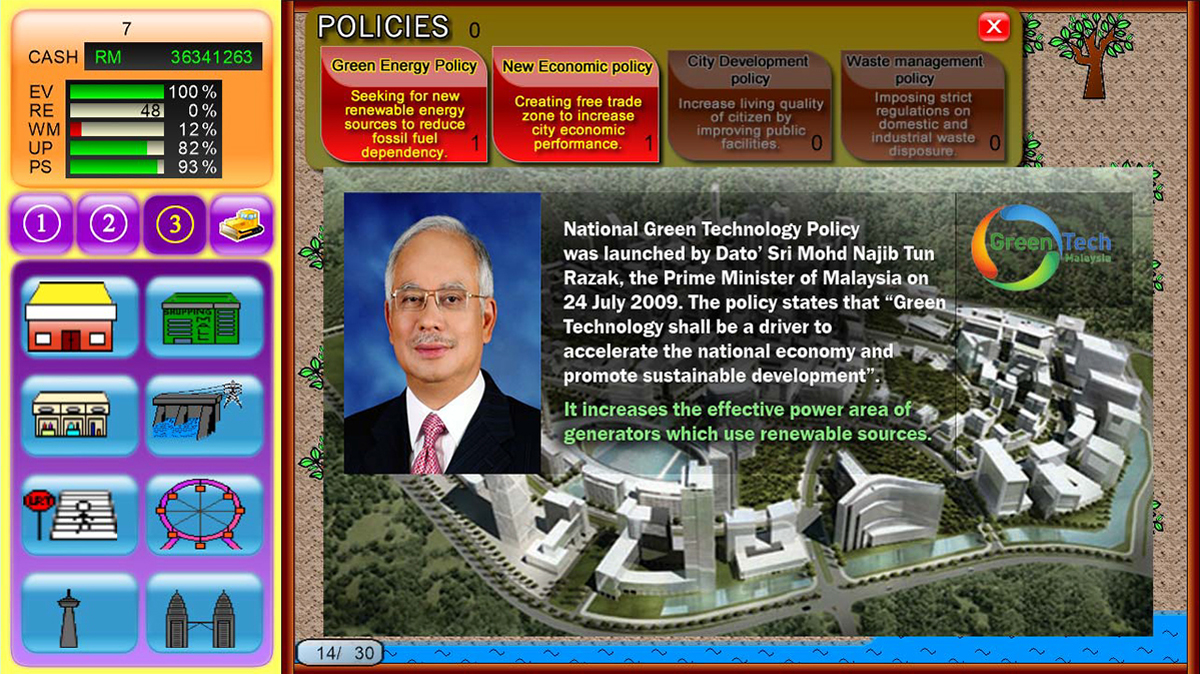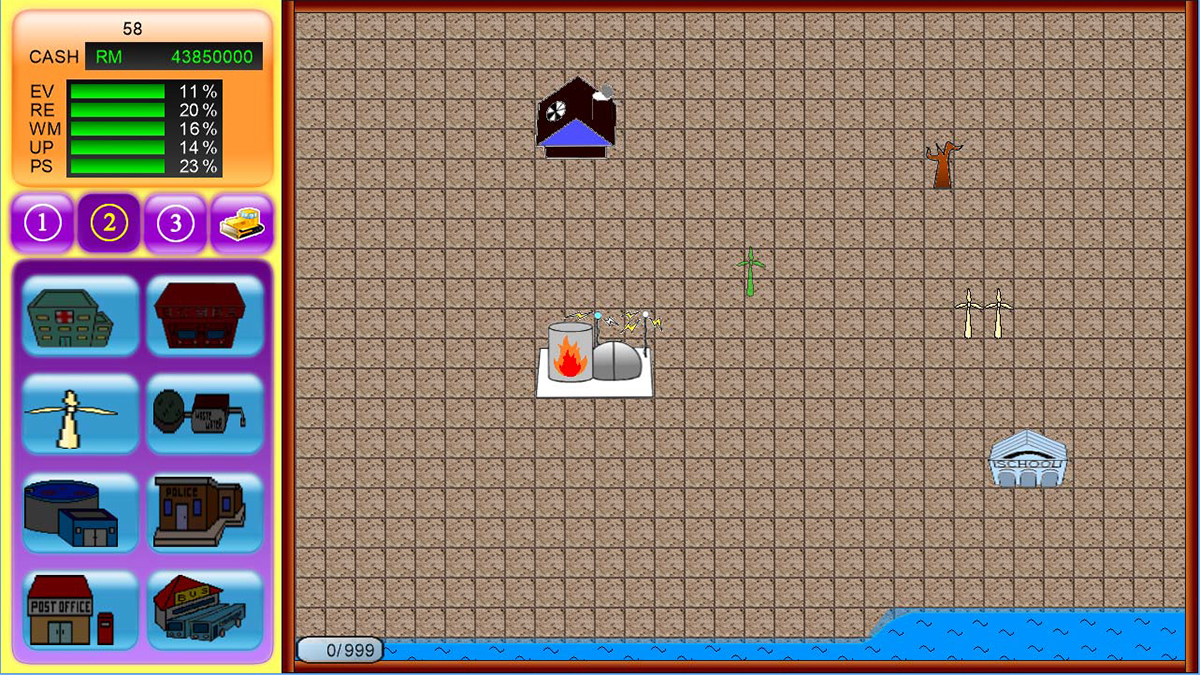I participated in a games design competition organized by Siemens Malaysia during my studies at USM. The theme was to design a city building game to promote sustainability in Malaysia. I led a team of my coursemates to participate in the competition. Despite having no background in games design, we were able to fully develop a functional prototype using the XNA engine.
The whole design process was indeed a lot of fun for all of us involved. All the graphical assets and codes were developed from scratch. As we had no formal training in games design, the game was developed in a “cowboy” manner. The game was fully playable as designed but in hindsight, we should have given more thoughts into designing the “fun” factor. Perhaps if we had read Raph Koster’s “Theory of Fun” back then, we would have been able to improve upon the mechanics. As it were, the game was too fast paced with little room for exploring different strategies to achieve the win condition.
All in all, development of the game was definitely a memorable experience. Credits to my teammates who made this game happen: Lee Zhe Heng, Kiu Shiu Guong, Heng Peng Wei, and Heng Peng Zhi.


- An excerpt of the game overview from the game proposal:
-
In CityBuilder, the player gets a chance to build and design his own version of KL city. It is a hybrid of strategy and city simulation games where players get to build buildings and generate income throughout the game. The game responds to FIVE main aspects of the city, viz., Environmental Factors, Renewable Energy, Waste Water Management, Urban Planning, and Public Services.
-
Each of this aspect will be graded using a score value which will be increased or reduced based on the city planning and design (e.g. placement of buildings, types of buildings). Each building in the game has its own attributes which will contribute to the increase or decrease of the five abovementioned attributes. Different buildings will have both pros and cons which will affect the main aspects. For example, building a Hydroelectric Plant will decrease your Environmental Points but increase your Renewable Energy Points. The game is designed so that in the long run, building a Hydroelectric Plant, will eventually cover back the Environmental Points you lost earlier when you first built the plant. This is logical since building a hydroelectric dam would require demolishing the landscapes and destroying the environment but in the long run, it is still a clean source of renewable energy.
-
Similarly, building a factory will give you a lot of income but it will also decrease your Environmental Points and Waste Water Management Points. Another interesting example would be trees in the game. Trees, without a doubt should increase the Environmental Points but it will not do so the moment you first plant it! You have to wait for it to grow first. Initially it is only going to take up your building space (players have a limited build space) without any benefits but if you can wait for some time for it to grow, the final contribution to the Environmental Points is enormous. This again, models real life since most people would choose not to waste their resources to plant trees because you cannot see the results immediately. However, with time, the trees would grow and become a nice addition to the environment. It is exactly the kind of message that we wish to convey to the players playing our games, that if you have a little patience and heart, you would be able to reap what you have sowed!
-
Certain buildings also have special features which will contribute to bonus points of the game. For example, after players have built a Parliament building, he/she will be able to choose and set government policies which will add bonuses to his/her game (e.g. Selecting to set the New Economic Policy will increase the income of the player by a certain factor). The policies in the game are modeled after real life government policies in Malaysia (e.g. The New Economic Policy is a government policy set by then Prime Minister Tun Abdul Razak). This is done to expose and teach the players about government policies in Malaysia. Relative location of buildings will also factor into the gameplay. For example, building a factory nearby residential areas will decrease the Urban Planning Points. But building a school nearby residential areas will increase your Urban Planning Points instead. For power generation, the buildings only can be built if there is sufficient power to supply it, which means bigger city would requires more power generator. The task of choosing between a more sustainable energy source such as wind energy or to use fossil fuel is entirely up to the player but as usual, they will each have their pros and cons.
-
The game is intended to be filled with a lot of real world facts about how city building will affect the environment and how to overcome it. The final goal of the game is to sustain the city for 50 years with a full score on all the five city aspects, which are Renewable Energy, Waste Water Management, Urban Planning, Public Services and Environmental Factors. The game ends after 50 years and the final score of the city aspects will determine the rank of the city, such as “Average city”, “Superb city”, and so on. Last but not least, the pacing of the game is intended to be fast. If the player does nothing to overcome problems with his/her city, it will gradually decrease the points and eventually causes the game to be over.
-
So it teaches yet another valuable lesson to players, to value time in saving the environment!





